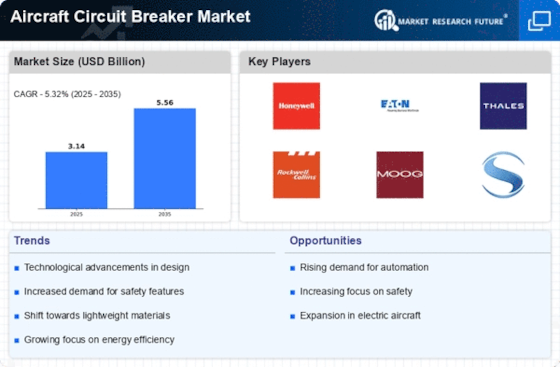Expansion of the Aviation Sector
The Aircraft Circuit Breaker Market is poised for growth due to the expansion of the aviation sector. With the increasing number of aircraft being manufactured and the rise in air travel, the demand for reliable circuit breakers is surging. The International Air Transport Association (IATA) forecasts that the number of air passengers will reach 8.2 billion by 2037, indicating a robust growth trajectory for the aviation industry. This expansion necessitates the production of new aircraft, which in turn drives the need for advanced circuit protection solutions. Manufacturers are responding by developing circuit breakers that not only meet current safety standards but also anticipate future regulatory changes. As a result, the Aircraft Circuit Breaker Market is likely to benefit from this upward trend in aviation, leading to increased investments in research and development.
Growing Focus on Energy Efficiency
The Aircraft Circuit Breaker Market is witnessing a growing focus on energy efficiency, driven by the aviation sector's commitment to sustainability. Airlines and manufacturers are increasingly prioritizing the reduction of fuel consumption and emissions, which has led to the development of more efficient electrical systems. Circuit breakers play a vital role in optimizing energy use within aircraft, and innovations in this area are becoming essential. The market is expected to grow as manufacturers introduce circuit breakers that minimize energy loss and enhance overall system efficiency. Additionally, the push for greener technologies is prompting investments in research aimed at creating circuit breakers that align with sustainable practices. This trend indicates that the Aircraft Circuit Breaker Market will continue to evolve, reflecting the broader shift towards energy-efficient solutions in aviation.
Regulatory Compliance and Standards
Regulatory compliance is a crucial driver in the Aircraft Circuit Breaker Market. Governments and aviation authorities worldwide are implementing stringent regulations to enhance safety and reliability in aircraft operations. These regulations often require the use of advanced circuit breakers that can withstand extreme conditions and provide reliable performance. The Federal Aviation Administration (FAA) and the European Union Aviation Safety Agency (EASA) have established guidelines that manufacturers must adhere to, which influences product development and innovation. As compliance becomes increasingly complex, manufacturers are investing in R&D to ensure their products meet these evolving standards. This focus on regulatory compliance is likely to propel the Aircraft Circuit Breaker Market forward, as companies strive to maintain their competitive edge while ensuring safety and reliability in their offerings.
Increased Demand for Aircraft Safety
The Aircraft Circuit Breaker Market is experiencing heightened demand driven by the increasing emphasis on safety in aviation. Regulatory bodies are mandating stricter safety standards, which necessitate the incorporation of advanced circuit breakers in aircraft systems. This trend is underscored by the projected growth of the aviation sector, with estimates suggesting a rise in air traffic by 4.5 percent annually over the next decade. Consequently, manufacturers are compelled to innovate and enhance the reliability of circuit breakers, ensuring they meet the evolving safety requirements. The integration of smart technologies into circuit breakers further supports this demand, as these innovations provide real-time monitoring and fault detection, thereby enhancing overall aircraft safety. As a result, the Aircraft Circuit Breaker Market is likely to witness substantial growth, driven by the imperative for improved safety measures.
Technological Innovations in Circuit Breakers
Technological advancements are a pivotal driver in the Aircraft Circuit Breaker Market. The introduction of digital circuit breakers, which offer enhanced performance and reliability, is transforming the landscape. These innovations allow for better fault isolation and quicker response times, which are critical in aviation applications. The market is projected to grow at a compound annual growth rate of approximately 5.2 percent, reflecting the increasing adoption of these advanced technologies. Furthermore, the integration of Internet of Things (IoT) capabilities into circuit breakers enables predictive maintenance, reducing downtime and operational costs. As aircraft manufacturers seek to improve efficiency and reduce weight, the demand for lightweight and compact circuit breakers is also on the rise. This technological evolution is likely to shape the future of the Aircraft Circuit Breaker Market significantly.

















Leave a Comment